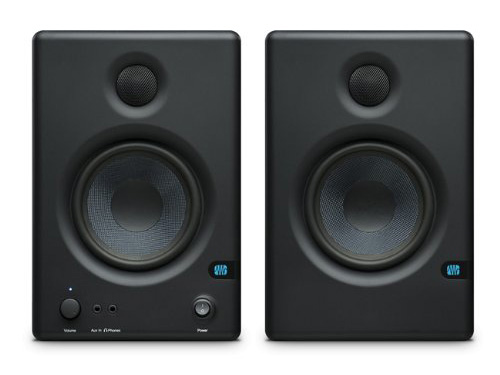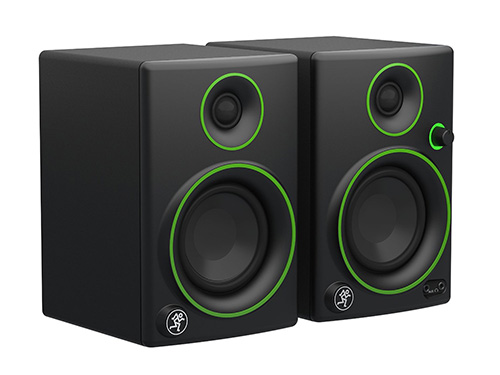Studio Monitor Reviews
(Including 1 or 2 Reference Speakers)
Many people who are now getting into vintage vinyl audio are not interested in putting together an expensive and space-eating component system. Modern speaker technology also means that you no longer have to have huge speaker cabinets for room-filling sound. It’s amazing what a pair of good desktop speakers can achieve in terms of frequency, volume, and clarity.
One of the easiest ways to get a pretty decent turntable setup is to connect the line output on your phono preamp directly to a set of active speakers.
What’s an active speaker? Well, simply put, it is a speaker that has an amplifier built into the speaker cabinet itself. This makes for a much more compact system, with fewer wires and fewer headaches. The power goes directly to the speaker itself. There may be one amp in the main speaker that drives both, or each speaker cabinet may have it’s own amplifier.
Of course there are some drawbacks as well. There’s less room for the speakers in the cabinet and they are heavier, but modern amps are much smaller and less power hungry than in the past, so this is not much of a negative.
Here I have taken examples from the most popular active speakers sold online today. Of course these are not vinyl specific in general, but they represent the products that people are buying in the highest numbers and are most likely what you’ll come across for your potential shopping list.
Some of these speakers are “monitors”, which are usually tuned to have a “flat” frequency response and introduce as little coloration into the audio as possible. The idea is that you’ll hear exactly was recorded or as close to it as possible. Reference speakers, on the other hand, sound like regular consumer audio, but as a sort of best case; giving you a wide frequency response and lots of detail in the audio. Neither type of speaker is “right” but each person may consider the different approaches to sound fidelity most to their liking.
So I have highlighted which I think are the best products in different ways, listing my top choices first. The rest of the products are not listed in any particular order.
Top Pick:
KRK RP7 Rokit 7 G4 Professional Bi-Amp 7″ Powered Studio Monitor
The KRK Rokit RP7 G4 comes in single-unit form. So if you want stereo sound, you can just go ahead and double the price. Yes, these are not cheap on a per-speaker basis, but compared to some of the bigger names on the market the G4 is a bit of a bargain.
With a bi-amp design and kevlar drivers, fidelity is the name of the game with this beauty. Even at max volume, special limiter systems ensure that all frequencies remain integral. As you’d want with a monitor, the enclosure itself is designed to cause as little resonance and sound corporation as possible. So these are definitely suitable for mixing your own audio as well, if you get tired of enjoying the music of others.
The feature of these speakers I really like is the inclusion of the KRK app. You can connect your speaker and use the app to fine-tune it to your exact needs. As an overall package, the Rokits are hard to overlook. This is what I would buy.
Mid-Range Pick:
PreSonus Eris E4.5 Studio Monitors
PreSonus is not a brand that I’m familiar with, but they certainly know how to design a handsome pair of speakers. I like the looks of these guys – there are no funky colors here, but they still look cool.
The pricing is halfway between entry-level and mid-level. Hopefully this means that some of the iffy build quality we see with the sub-$100 speakers will be less evident here. The sub is a 4.5-inch kevlar unit, which is just cool to say, honestly. You can tell people that you have bulletproof speakers – sort of. Don’t shoot them.
Each speaker has a healthy 25W of power and the frequency response of 70 Hz to 20 kHz. That’s a smidge disappointing, actually. There are cheaper speakers that are wider at both ends of the spectrum and some people can hear above 20 kHz even later in life. Still, most people past their twenties have descended solidly into the world of 18 kHz and nothing higher.
I do like the flexibility that these provide. You can run them as monitors with a flattened response, but you can also choose from several deliberate coloration simulations.
Opinions on the sound of these speakers are almost uniformly positive and they come highly recommended for home users, even by professional audio engineers. It think this is a great compromise between the price of the Rokits and the frailty of cheaper speakers. It’s also a good thing that these are so compact. If you are short on space this becomes an even better choice.
High-end Pick:
Swans Speakers – X4 – Professional Active Studio Monitors
I absolutely love the design of the Swans. They’re like some sort of retro-futuristic space speakers that are what I imagined future stuff looked like back in the 90s. The almost egg-shaped speakers are very pleasing to the eye. Wherever I look, there’s a curve or surface I like.
These speakers are the real deal too. They are designed specifically for audio engineering and, though not the most expensive units, have some pretty impressive specs. They are also very practical indeed. With thick rubber bases and straight forward tuning controls on the side, you don’t have to be too finicky about where you put them and can tune them to your needs in no time at all.
These active monitors can go down all the way to 55 Hz. An achievement for speakers with such relatively small subwoofers. Professionals seem to attest that they are subjectively equal to more expensive professional speakers on the market from well-regarded brands. So it seems that the Swans are one of those rare sweet spot products that you should grab before the manufacturer gets wise and re-releases them for more money.
Top Entry-Level Pick:
Mackie CR Series CR3 Reference Speakers
Mackie is a name that I immediately associate with rock and roll music equipment. Knowing them for their live audio equipment, it can be hard to remember that they are good at a range of product types.
These reference speakers are massively popular and by just looking at them you can tell why. They manage to look like professional studio equipment, while that strategic dash of neon color gives them rockstar credibility. Suffice it to say I like the looks of these speakers a lot.
Since these are reference speakers, you’ll get the EQ emphasis of home HiFi equipment, so be sure that’s what you want. This does make them suitable for use in place of that HiFi equipment, however, and the goods news is that their specs look great.
With a range of 80Hz to 20 kHz you really are getting the full range of your audio or at least the bits you are able to hear. That’s great for vinyl, which has such a wide frequency range.
At this price these speakers are incredible value for money. The speakers are powerful, but designed in such as way so as not to distort or perform poorly within their rated levels. There is also a lot in terms of user-friendly features.
One of my favorites is the fact that you can put the speakers in any left-right order you want. There’s a manual stereo flipping switch on the units themselves – such a simple idea that solves a pet peeve of mine.
Apart from your turntable, you can easily connect a range of things to these speakers. The AUX inputs are on the front panel, so Mackie really has designed these to be at the center of your audio equipment. One thing you’ll have to give up for this entry-level model is Bluetooth, which is a neat feature.
The CR3s also come with a lot of patch cords and other cables. Buying new equipment only to realize that you have to head back out to find the right cable is one of those painful realities audio geeks have to face, but even at this price Mackie has done their bit to be the good guys. It even comes with isolation pads right out the box.
The only downside, of course, is that this has the smallest subwoofer in the range, at only three inches. This does not affect the frequency range in any way that matters, but the bass is not as powerful as that of the higher-up models. Still, you get the same total amount of wattage at 50W, so these can kick butt in most rooms.
Some professional users have noted that the bass is a bit overemphasized, but that’s not the use case I’m looking at for them here. If you want speakers that give great HiFi sound from your vinyls, these will do the job well.
The only really worrying thing here to me is the smattering of complaints from people that experienced build quality issues – switch failures and other unexplained problems. Still, it’s not widespread and there’s always warranty returns. As a great entry-level product to expand your music listening experience, I like these quite a lot.
Vinyl Vintage Audio System Reviews
If you’re completely new to the world of vinyl and vintage audio, I’d recommend to start with the reviews on Turntables, Phone Preamps, Record Cleaners and Speakers. Once you’ve got this covered, make sure to check the menu for more of my reviews.
Turntables Record Cleaners Phono Pre-Amps Bookshelf Speakers





